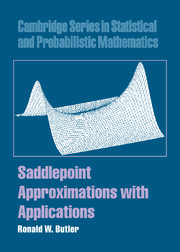Book contents
- Frontmatter
- Contents
- Preface
- 1 Fundamental approximations
- 2 Properties and derivations
- 3 Multivariate densities
- 4 Conditional densities and distribution functions
- 5 Exponential families and tilted distributions
- 6 Further exponential family examples and theory
- 7 Probability computation with p*
- 8 Probabilities with r*-type approximations
- 9 Nuisance parameters
- 10 Sequential saddlepoint applications
- 11 Applications to multivariate testing
- 12 Ratios and roots of estimating equations
- 13 First passage and time to event distributions
- 14 Bootstrapping in the transform domain
- 15 Bayesian applications
- 16 Nonnormal bases
- References
- Index
7 - Probability computation with p*
Published online by Cambridge University Press: 25 February 2010
- Frontmatter
- Contents
- Preface
- 1 Fundamental approximations
- 2 Properties and derivations
- 3 Multivariate densities
- 4 Conditional densities and distribution functions
- 5 Exponential families and tilted distributions
- 6 Further exponential family examples and theory
- 7 Probability computation with p*
- 8 Probabilities with r*-type approximations
- 9 Nuisance parameters
- 10 Sequential saddlepoint applications
- 11 Applications to multivariate testing
- 12 Ratios and roots of estimating equations
- 13 First passage and time to event distributions
- 14 Bootstrapping in the transform domain
- 15 Bayesian applications
- 16 Nonnormal bases
- References
- Index
Summary
The p* densitywas introduced in Barndorff-Nielsen (1980, 1983) and has been prominently featured as an approximation for the density of the maximum likelihood estimate (MLE). Its development from saddlepoint approximations and its role in likelihood inference for regular exponential families are discussed in section 7.1. Section 7.2 considers group transformation models, such as linear regression and location and scale models. In this setting the p* formula provides the conditional distributions ofMLEsgiven a maximal ancillary statistic and agrees with expressions developed by Fisher (1934) and Fraser (1979). In curved exponential families, the p* formula also approximates the conditional distribution of MLEs given certain approximate ancillaries. This development is explored in section 7.3 with a more detailed discussion given for the situation in which the ancillaries are affine.
The p* density in regular exponential families
In the context of a regular exponential family, the p* density is the normalized saddlepoint density for the MLE. In its unnormalized form in the continuous setting, p* is simply a Jacobian transformation removed from the saddlepoint density of the canonical sufficient statistic. Consider the regular exponential family in (5.1) with canonical parameter θ ε ε ⊆ ℜm and canonical sufficient statistic X. Statistic X is also the MLE û for the mean parameterization μ = c′(θ) as discussed in section 5.1.2.
- Type
- Chapter
- Information
- Saddlepoint Approximations with Applications , pp. 219 - 258Publisher: Cambridge University PressPrint publication year: 2007
- 1
- Cited by



